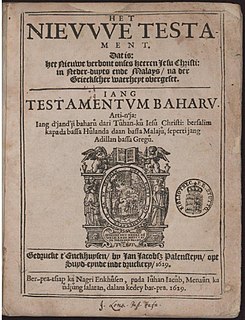
The New English Bible (NEB) is an English translation of the Bible. The New Testament was published in 1961 and the Old Testament was published on 16 March 1970. In 1989, it was significantly revised and republished as the Revised English Bible.

Bible translations into Chinese include translations of the whole or parts of the Bible into any of the levels and varieties of the Chinese language. The first translations may have been made as early as the 7th century AD, but the first printed translations appeared only in the nineteenth century. Progress on a modern translation was encumbered by denominational rivalries, theological clashes, linguistic disputes, and practical challenges at least until the publication of the Protestant Chinese Union Version in 1919, which became the basis of standard versions in use today.
Protestants in Japan constitute a religious minority of about 0.4% of total population or 509,668 people in number.
Although Christianity became the state religion of Ethiopia in the 4th century, and the Bible was first translated into Ge'ez at about that time, only in the last two centuries have there appeared translations of the Bible into Amharic.
James S. Gale was a Canadian Presbyterian missionary, educator and Bible translator in Korea.

Archdeacon John Batchelor D.D., OBE was an Anglican English missionary to the Ainu people of Japan until 1941. First sent under the auspices of the Church Mission Society of the Church of England, Batchelor lived from 1877 to 1941 among the indigenous Ainu communities in the Northern Japanese island of Hokkaido. He was a charismatic and iconoclastic missionary for the Anglican Church in Japan and published highly regarded work on the language and culture of the Ainu people. Batchelor only reluctantly left Japan at the outbreak of the Second World War in 1941.
The complete Bible has been translated into three of the dialects of Inupiat language, the New Testament in two more and portions in another.
The earliest preserved translation of the Bible into the Mongolian language dates to 1827, but there is a written record of what may perhaps have been a translation existing as early as 1305. Since 1827, numerous other translations have been made.

Bible translations into Hebrew primarily refers to translations of the New Testament of the Christian Bible into the Hebrew language, from the original Koine Greek or an intermediate translation. There is less need to translate the Jewish Tanakh from the Original Biblical Hebrew, because it is closely intelligible to Modern Hebrew speakers. There are more translations of the small number of Tanakhas passages preserved in the more distantly related biblical Aramaic language. There are also Hebrew translations of Biblical apocrypha.
Bible translations into Oceanic languages have a relatively closely related and recent history.

Bible translations in Norway date back to the late 13th century. Since the first spread of Christianity in Norway, numerous translations of the Bible have been published. Translations have appeared in several of the official languages that Norway has had throughout its history, including editions in Old Norse, Danish, and both current standard forms Nynorsk and Bokmål.
Biblical translations into the indigenous languages of North and South America have been produced since the 16th century.

The Athabaskan language family is divided into the Northern Athabaskan, Pacific Coast Athabaskan and Southern Athabaskan groups. The full Bible has been translated into two Athabaskan languages, and the complete New Testament in five more. Another five have portions of the Bible translated into them. There are no Pacific Coast Athabaskan languages with portions of the Bible translated into them.

Bible translations into the languages of Indonesia and Malaysia have a lot of common history up until the modern era. Apart from the shared Malay language which historically was the lingua franca of the Malay archipelago and forms the basis for the national languages of Indonesia and Malaysia today, portions of the Bible have been translated into a variety of indigenous languages in the region.
The Bible, or portions of it, have been translated into over 1,000 languages of Africa. Many of these are indexed by the Forum of Bible Agencies, Find.Bible site and available online in text and audio form, as print on demand versions, or through churches and book sellers. This effort continues. Not all are (yet) listed below.
Traditionally Russia used the Old Church Slavonic language and Slavonic Bible, and in the modern era Bible translations into Russian. The minority languages of Russia usually have a much more recent history, many of them having been commissioned or updated by the Institute for Bible Translation.
Taveta or 'Tubeta' one of the Northeast Coast Bantu languages of Kenya, closely related to Pare, that is spoken by the Taveta people.
Thomas John Dennis (1869-1917) was an Anglican priest who was the main translator of the Bible into the Igbo language.

Bible translations into Malay include translations of the whole or parts of the Bible into any of the levels and varieties of the Malay language. Publication of early or partial translations began as early as the seventeenth century although there is evidence that the Jesuit missionary, Francis Xavier, translated religious texts that included Bible verses into Malay as early as the sixteenth century.








